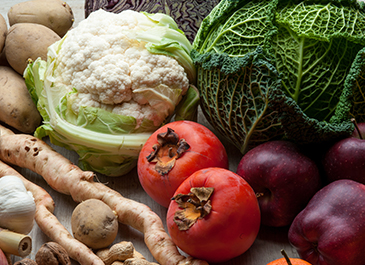As the feasting season approaches, what’s a budding locavore to do? The shelves are stocked with imported delights just begging to be selected, and the bounty of summer is far behind us. Given our northern home, 100% local might not be possible for each and every one of us—but it doesn’t mean we have to forgo local food throughout the dark and rainy winter. Read on for some tips on eating local all winter long.
Plan Ahead
The key to really making a go of local winter eating is to stock up in advance. So next summer, while the fields are full of perfect produce, take a few days off from the beach and get busy! Buy berries and peaches by the flat and freeze to store for winter smoothies and baking. Freeze berries and cut peaches on a cookie sheet so they don’t stick and then transfer to heavy-duty freezing bags. If you have an extra shelf or two, try your hand at canning. Chutneys and other acidic foods are a safer bet for new canners as their natural acid levels help discourage bacterial growth. Tomatoes and tomato sauce are a bit trickier but come in handy through the winter for soups, pasta, and casseroles. There are plenty of “canning for beginners” courses out there—be sure to learn from the pros (that includes grandma!) to avoid mishaps.
What to Eat
People cannot live on pickles and berries alone…so roll up your sleeves and get shopping! For ideas on what is in season right now and just where you can pick up these winter treasures explore websites like Edible Communities or Get Local BC. Hot chocolate in hand, spend the morning at the Winter Farmer’s Market or look in store for made in BC produce and food products.
What is available through the winter in BC? More than you might think! Winter greens like kale, bell peppers, meats, cheeses, grapes, apples, potatoes, beets, turnips, pumpkin, squash, carrots, mushrooms, hazelnuts, garlic…enough to keep your kitchen humming. Make local winter produce the centerpiece of your meal and pull in a few supporting staples like whole grains, condiments and imported produce to round out the meal.
A Measured Approach to Local
It is important to remember that while completely local eating can be achieved with some effort, even a 50% local diet in the winter goes a long way to supporting local producers and reducing your carbon footprint with your sanity intact. A Local Table, Choices’ own cookbook, helps you select seasonal recipes using the best of BC all year long. Now, what to do for the holiday feast? Local specialty turkey? Check! Locally harvested cranberries? Check! Candied local yams? Check! A bit of dark chocolate for dessert?…make it fair trade and enjoy.
Have a nutrition question? Email nutrition@choicesmarkets.com or get nutrition tips on Twitter by following @ChoicesMarkets.

